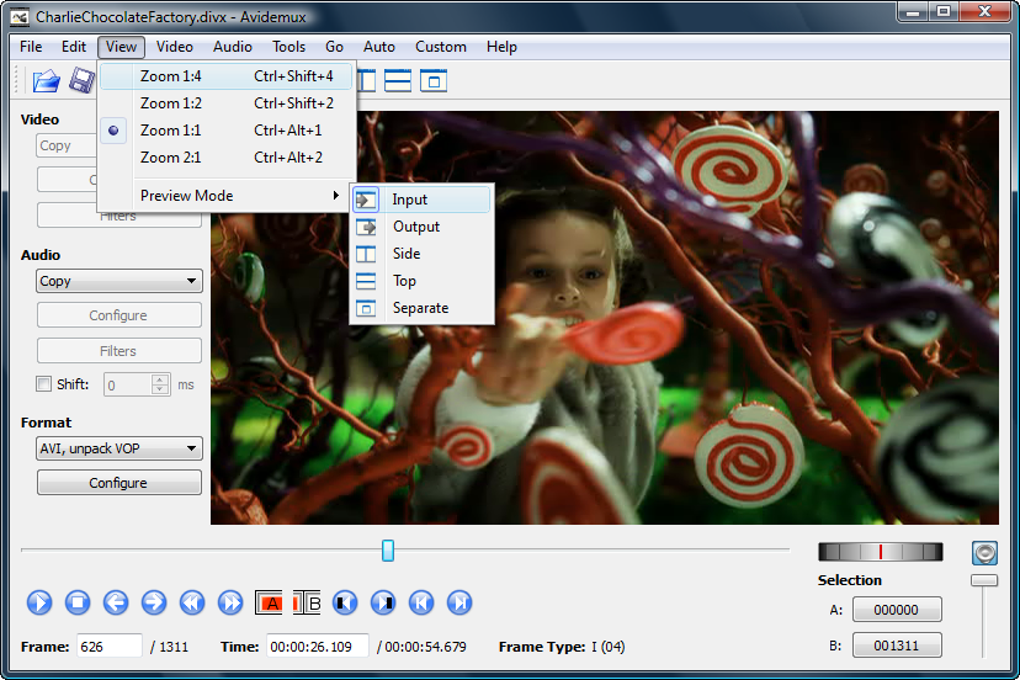

that is x264, configure it, add video filters like deinterlace, crop and resize to make the video more compressible, select Matroska or MP4 as the container format and save the file. DEINTERLACING When processing video files you might want to add. It appears to be the very same filter because it gives the very same results I obtained in Avidemux. TRIMMING A VIDEO FILE If needed you can trim the video file using Avidemux before you save it. To replicate the cubic interpolate filter capability in Avidemux you would use this filter stream: -vf ppcia or -vf ppcubicipoldeintautoq. The keyword here is simple: it does not offer tools like a timeline. FFmpeg has a video postprocessing sub filter set, specifically 10.140 pp. It enables monitoring of an Avisynth clip via previewing the video, viewing clip information (such as video width, height, colorspace, number of frames, audio samples, sample rate, number of audio channels, and more), and adjusting the audio delay. Avidemux is a simple tool for simple video processing tasks. Document Revision History for the Video and Image Processing Suite User Guide A. TMonitor is a filter very similar to AVSMon. If you want to try Yamb simply, double click on create an mp4, drag your video into Yamb, select just the video track in the window and on the right click the properties tag. Video and Image Processing Suite User Guide Archives 30.
#Avidemux crop deinterlace pro
Avalon-ST Video Stream Cleaner IP Core 26. FXMahoney has come up with a rather neat FCPX deinterlace: Peter WigginsHow to Deinterlace in Final Cut Pro X Dei. About the Video and Image Processing Suite 2.

Now you can process it to suit your needs. Plug the medium to a computer and copy the file into it.

A 1 hour video takes around wenty minutes. ( follow the ' Opt+ ' button on the zapper). values for various threshold settings, etc.1. Use the USB outlet to copy the video file to a memory stick or an externa hard drive. Try backwards - Never, If still combed, Always Postprocessing - None, None but compute, Postproc on best match, Postproc and show zones, Process image (not fields), Process image (not fields) debug Strategy - No strategy, 3-2 pulldown, PAL/SECAM, NTSC converted from PALįield order - Top, Bottom (this seems completely superfluous as my source isn't interlaced, but I have to select one of these) This filter takes two parameters : Motion threshold : The lower this value, the more easily the interlacing will be detected. However, my struggles have come from the tutorials out there being a bit light on detail when it comes to selecting the options. Deinterlace This filter is a port of Donald Graft smart-deinterlace filter to YV12 It detects if the image is interlaced and blurs the interlaced parts. I've tried using Avidemux's deinterlacing filters (Decomb Telecide & Decomb Decimate) even though the source file isn't interlaced. You can simulate it in avisynth with mtconvolution('1','1 2 1',chroma'process') from masktools.
#Avidemux crop deinterlace free
I've used Avidemux for many years and I think it's wonderful for something that's completely free open-source, but getting it to delete duplicate frames has caused me to pull my hair out many times over! Blend deinterlace is a vertical (1,2,1) kernel, which means each line is blended vertically with its neighbors, to give a decent impersonation of two whole frames blended. Viewing it in a typical media player looks too jerky for my liking, so I'd like to delete the duplicated frames and end up with my video running at the 'true' speed of 24 fps. I have a piece of video that's exactly 30 fps but every fifth frame is a (visually exact) duplicate of its predecessor, suggesting that its true framerate was 24 (or perhaps 23.976) fps.


 0 kommentar(er)
0 kommentar(er)
